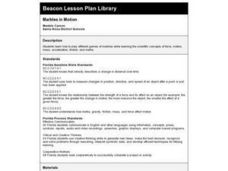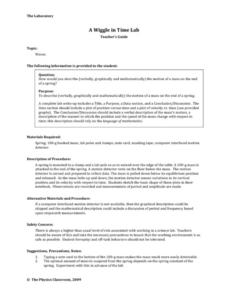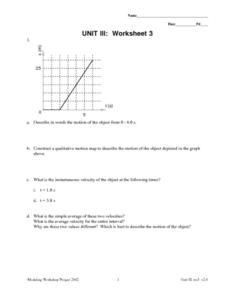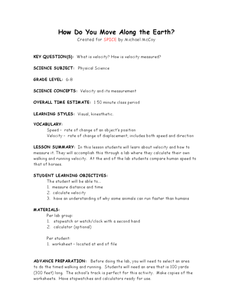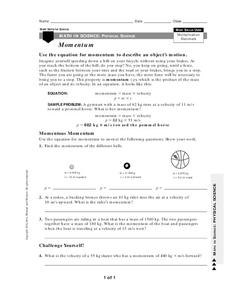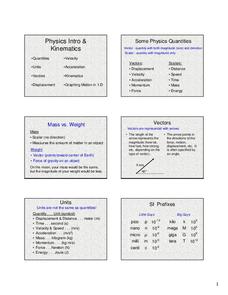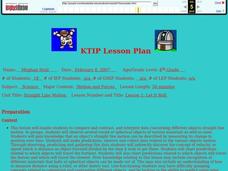Curated OER
Marbles in Motion
Fourth graders explore how to play marbles while learning the scientific concepts of force, motion, mass, acceleration, friction, and inertia.
Curated OER
Crash Test Dummies
Fifth graders are introduced to Newton's First Law of Motion. In groups, they describe the differences between balanced and unbalanced forces. They participate in experiments that demonstrate how equal and opposite forces act upon...
Physics Classroom
A Wiggle in Time Lab
Though an alternative method is suggested, the best way to carry out this investigation is with the use of a computer-interfaced motion detector. Physics fanatics hang a mass on the end of a spring and analyze its motion verbally,...
Curated OER
Speedy Spaghetti
Students explore the principles of motion by constructing a car out of pasta that will carry a large marshmallow and travel down a ramp. They discuss the formula for calculating speed, design and build their cars, and calculate their...
Curated OER
Unit III: 3
In this unit III: 3 worksheet, students describe motion in words and graph drawings. Students calculate the instantaneous velocity and average velocity. Students also graph the displacement of the object in the word problems.
Curated OER
The Great Tin Race
Students construct and race tin can cars. In this motion lesson plan, groups build tin racers, complete timed runs, and record their data on the provided worksheet. The teacher leads a discussion comparing data between groups. Specific...
Curated OER
How Do You Move Along the Earth?
Students determine their own walking and running velocity. For this physics lesson, students calculate velocity using distance and time information. They compare human and animal speeds.
Curated OER
Going the Distance
Students experiment in small groups to answer the question, "Is there a relationship between ramps and speed?" They apply a formula to calculate the speed of the cars used in the experiment, complete the associate lab report, and...
Curated OER
Volcanoes are a Blast-Working with Simple Equations
In this projectile motion learning exercise, students solve 3 problems and an inquiry problem using three equations that describe projectile motion. One equation is for the maximum velocity to reach a height, H, the other is the maximum...
Curated OER
Medieval Catapults
Young scholars design and build a working catapult or trebuchet to explore the concepts of force, motion, and distance.
Curated OER
Rock-A-Bye Pendulum
Third graders analyze the effects of force on an object in motion and its relationship to a change in speed. This lesson plan uses a pendulum to demonstrate the principle.
Curated OER
Position, Velocity & Acceleration vs. Time
In this motion activity, students use a graph showing the velocity of an object over time to describe the motion of the object and to determine the position of the object at different intervals. Then students create speed vs. time and...
Curated OER
Momentum
In this momentum worksheet, learners use the equation for momentum to describe an object's motion. This worksheet has 4 problems to solve.
Curated OER
Newton's Laws
In this motion worksheet, students read about the 3 laws of motion and then complete a graphic organizer describing the laws and giving an example for each one.
Curated OER
Blast Off!
Fourth graders investigate the third law of motion. In this third law of motion lesson plan, 4th graders explore the forces necessary for a rocket to launch. Students compare and contrast propellant and fuel. Numerous resources are...
Curated OER
Newton: Force and Motion
In this forces instructional activity, students use the equations for acceleration and Newton's second law to learn about different motions and forces. This instructional activity has 7 problems to solve.
Urbana School District
Physics Intro, Kinematics, Graphing
Some consider physics the branch of science concerned with using long and complicated formulas to describe how a ball rolls. This presentation, while long, is not complicated, yet it covers rolling, falling, and more. It compares vectors...
American Museum of Natural History
Train of Thought
Hop aboard the train of thought. A remote learning resource has learners consider thought experiments to consider scientific theories. It provides two examples, one on orbiting bodies and the other on the speed of light, for them to work...
Curated OER
Laws of Motion
Students explore centrifugal and centripetal force. In this motion lesson, students expand on their knowledge of motion to study velocity, acceleration, and friction. Students examine multiple objects to demonstrate the laws of motion.
Curated OER
Speed Trap
Students conceptually explore motion graphing by producing motion at different speeds and directions. They experience the lab and then graph the motion of the truck at various speeds and directions. The procedures of velocity are...
Curated OER
Motion Through the Ages
Eighth graders conduct internet research to produce a timeline of man's growth in understanding of concepts of motion and planetary motion through history.
Curated OER
How Can Motion Be Described?
In this motion worksheet, students complete a graphic organizer by describing the different ways an object can move: position, distance, direction, and speed.
Curated OER
Newton's Second Law of Motion
Sixth graders study Newton's second law of motion and verify it. In this force and motion lesson students complete a lab activity and collect data, analyze it and graph it.
Curated OER
Straight Line Motion
Fourth graders compare/contrast and interpret data concerning different objects straight line motion. They observe several round or spherical objects of various materials and sizes. Students make predictions, observe and collect data...


